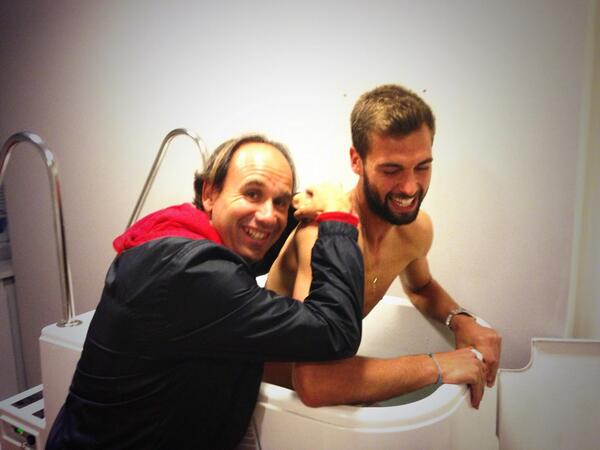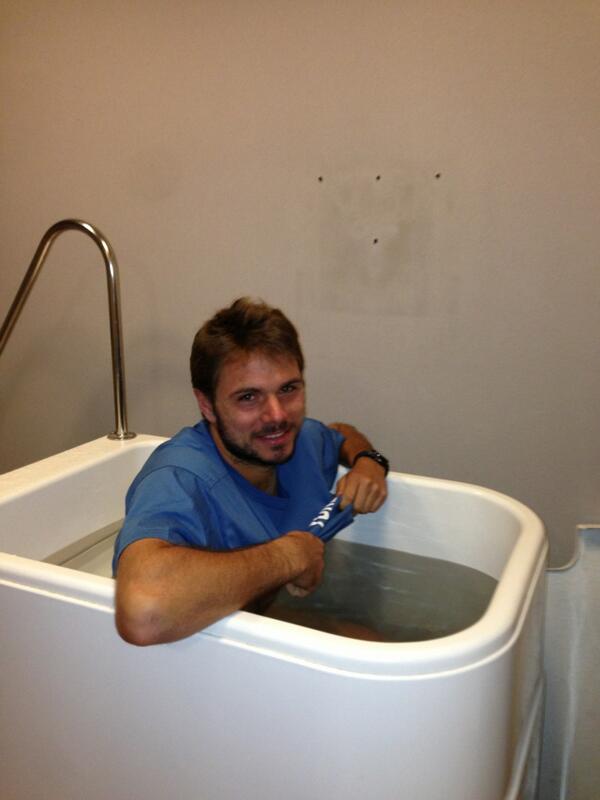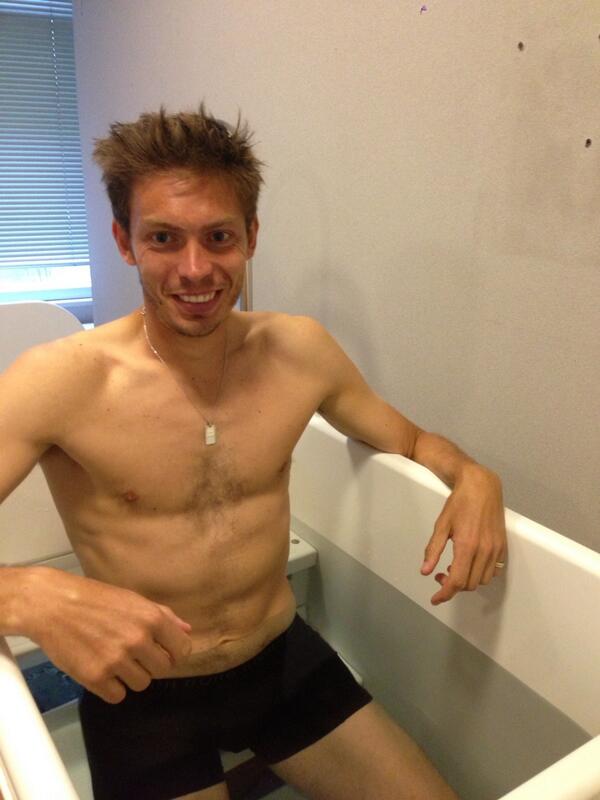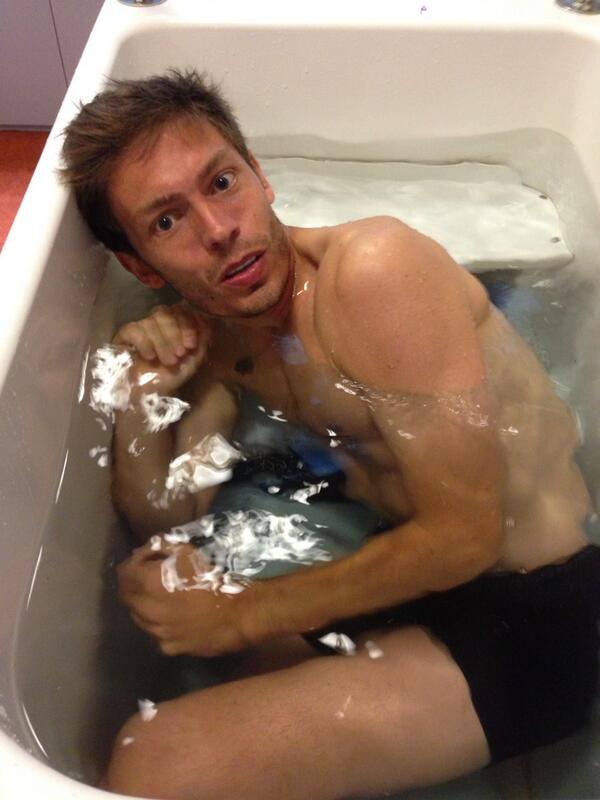Sergiy Stakhovsky gave a long and extensive interview to Eurosport Russia’s writer, Ilya Minskiy. I’ve translated excerpts from the interview, and I’m posting them here in order, with short descriptions of the parts I’ve omitted – if a topic seems interesting to you, let me know and I’ll try to fill in some of the missing parts later on.
This is the second Stakhovsky interview I’ve translated; the first was published about a year ago, and touched some of the points which he’d discussed here too.
Disclaimer: English is not my first language. I tried to translate as closely to the origin as I could, any mistakes are mine, and so are any irregularities in language.
–Anna
Sergiy Stakhovsky: "After Wimbledon they started recognizing me in Switzerland"
Chasing Federer’s conqueror for a while, I finally caught up with him when he played at the challenger event in Kazan. Sergiy is finally doing well - he won the tournament without losing a single set, thus interrupting a series of setbacks that began immediately after the most resounding victory of his career.
- Kazan uses the "Rucourt" surface, which causes many complaints during the Kremlin Cup. How is it for you?
- I can also complain. It is uneven, or more precisely, not the same across the entire surface. There are lines which are faster, some that are slower, as a result the kickbacks are different, and sometimes the ball bounces as it wants. But in terms of speed, it is quite comfortable.
- You're a prominent opponent of the widespread slowdown of the courts. Who supports you in this matter?
- Well, it’s not that I’m looking for support. It’s just that everyone has a view of their own on this issue. I think Federer is also not really happy about the courts slowing down. That is my position, but I did not collect signatures, although I'm sure I would’ve found support from a couple of dozen people for sure. At the time, it was made clear to us that the choice of surface is the prerogative of the tournament organizers. Tennis players can bang their heads against the wall, but it won’t help. They will choose the court surface for their tournament, even more precisely, in most cases for the player that they’re buying for their tournament. For example, if they buy Nadal – you can expect the surface to be very slow. And so on.
- You want to say that the ATP has nothing to do with it?
- No, it's all from the organizers. They wanted more spectacular tennis with long rallies - that's what happened.
- You are a permanent member of the ATP Player Council. Do you see any real benefits from its activities?
- I see, but in the first year there were more benefits than there are now. Everyone achieved the goals that they wanted, calmed down a little bit, and each one is more focused on his tennis than on solving global issues. However, I think that during the US Open we’ll go back to work. We have a council meeting there - on Friday, if I'm not mistaken. We will dive into the work over the next season.
- You said that many of the goals have been achieved. Can you elaborate?
- Initially, we faced a challenge - to raise the prize money in the Grand Slam tournaments. It was the number one goal, and we achieved it, I think. Although, perhaps, we could do even better, and have it raised even more.
There were nuances around the Olympics, the calendar, breaks in the season. For example, the issue with the tournaments in Latin America: they wanted the tournaments to take place from the beginning of December and almost until the New Year. In that case, we would have an endless season. I am pleased that the Council dealt with this responsibly, and we left the tournament system as it is, retaining a certain off-season, when one can rest, other - play exhibition matches, if it’s beneficial and necessary.
There’s an entirely different issue - the system of commitment to tournaments. That's where we haven’t been able to go deep. As you know, there are a number of tournaments which are declared mandatory. For tennis players from the top 30 that's almost all "Masters" (except for Monte Carlo), four ATP 500 tournaments and two ATP 250 tournaments. The bottom line is that those who finished the year in the top 12 and went to all these tournaments, receive a bonus. It would be logical to give it to others, as well – those who went to all of these mandatory tournaments just the same, and there are about 40 of those players. However, only the first 12 are given the bonus; therefore the players' council doesn't see the point in everyone going, for example, to the tournaments in Indian Wells and Miami, which are absolutely not popular. Very few people want to go there for such a long period, but they are required to. Even those who are around the 70-80 rank, who can never dream of getting this bonus.
- Why are Indian Wells and Miami so unpopular?
- Well, while at Indian Wells the conditions for players are improving somehow, and prize money rises every year quite rapidly, in Miami, on the contrary, it’s a different situation in terms of accommodation, courts and all the facilities for the players. The stadium is ancient, and there’s nothing to say about the prize money - it is the lowest of all the Masters series tournaments. Plus, there's a large draw there. We get roughly the same money at [Paris] Bercy, but there it’s a draw of 48 players, and here - 96, and respectively, every round gets a lesser cut. There are talks going on about it, but what it will lead to, I don’t know, it’s going slow for now.
- You mentioned some nuances about the Olympics. What was it about?
- The organizers of each event, who see themselves in the week before or the week after the Olympics, understand that it will be difficult enough to fill the draw with good players. Therefore, each tournament is trying to get away from these weeks, find somewhere to move to. But, of course, it’s difficult to do, because there are a lot of tournaments, you can’t just move that easily. We are forced to think of a solution. There’s progress: for example, in Washington DC in the Olympic year they’ve introduced an increased prize fund, reduced the number of participants. Usually there are 48 players there, but in the Olympic year there were 32.
Generally, it’s a difficult process. We have to find a compromise, because the tournaments want to reduce their risk - and very strongly so. For example, Rogers Cup - they wanted to move to an entirely different week, and on a permanent basis. However, the idea seemed impractical, and the Council didn’t approve it.
- Speaking of prize money. Why is the Australian Open continually in front of everyone?
- To be precise, in the US Open the prize money is higher, but if you take into account the ratio of the tournament’s profit and the players’ compensation, then Australia is really ahead with a huge margin. Their treatment of players has always been different: they’ve always wanted to be the players’ Grand Slam. They constantly consult with us on the subject of what we would still like to see there, which courts to build, indoor or not, gyms and so on. There is constant progress, so they remain the leaders. Therefore many of the players say that the Australian Open is the most enjoyable Grand Slam.
- The US Open also has progress this year – they finally decided to build a roof.
- Decided ... Previously there was so much talk about it being impossible, and then suddenly they found the money that makes it possible. Unfortunately, the US Open is much more directed at commerce than at the development of tennis. Factually, their profits are twice as much as those of the Australian Open, only where does all that money go afterwards? Now, apparently they saved it for the roof.
- Here the most remarkable thing is that the first estimate was announced as five hundred million dollars, then it was suddenly reduced to a hundred. [I believe this is a misunderstanding – the roof’s cost is $100M, but the overall renovation project, including ground expansion and larger stands for show courts, will cost a total of $500M. –Anna]
- One hundred million? Their yearly profit is 2-3 times greater than this. They can not only afford to build a roof, but also a swimming pool beneath it. In any case, players will have it easier when at least one court will have a roof, as for several years already the US Open final is played on Monday. Moreover, in this season it has already been officially scheduled for Monday; thank God, it is only up to 2015, then everything will be back on Sunday.
- How is the story of your rebuke about the introduction of equal prize money in the ATP and WTA developing? Did you have conflicts with the girls?
- I never had any conflicts with the female players. Especially with our tennis players, I'm in normal relations with everybody. I never said that women should get less. The message was this: men should earn more. I still think so. It's not even the physical cost - five sets or three, this issue is marginal.
The main point is different. There is a certain product. This product is us, since we’re the ones people come to watch. We put up a show, and one show is very popular. So, I do not really understand why another show that’s going in parallel, should earn the same - with less attendance. I, in principle, do not know any other kind of work, where women earn as much just because they are women.
Take the modeling business. Do male models get as much as girls? No, but have you heard the men screaming about discrimination? In football and basketball – it’s all clear. Athletics? Does Isinbayeva get the same as Bolt? No, because what Bolt does is a higher quality and therefore more popular product. So explain to me why the ATP, which is a better product than the WTA, should have equal prize money with them?
- Sharapova didn’t agree with you, as far as I remember.
- She may or may not agree, it’s her right to do so. Yes, if she will play on Centre Court, and at the same time I'm going to play on another show court, more people will come to watch her. That’s not the essence, but rather the total number of spectators attending matches for men and women at all stages. And the men's matches have a larger attendance.
Here, of course, there are different and very serious reasons. I do not want to argue. I'm not a misogynist, as some describe me, it's not true. I very much love my wife. There just isn’t anything wrong in the fact that some things work this way and not otherwise, because that’s the way the world works. Why do football players make millions as compared to other athletes? Because hundreds of thousands of people come to watch them.
- In recent years, the ATP consistently reports new attendance records. It is clear that we are talking about the Grand Slam tournaments, but still. Do you, from your side, somehow feel increased excitement around tennis?
- It’s mainly about the Grand Slams, of course. Over the recent years a pool of players was formed who show a very high level: Federer, Nadal and company. For two weeks they are on fire - where, if not in the Grand Slams, can you see that? Of course, I would like the increased interest to be in lesser tournaments - the 500 and 250 categories, and so on. There, too, is a very high level of tennis, in spite of all the difficulties, but often it goes, I’d say, unnoticed.
- It’s probably not worth it to even talk about challengers. You just played in Kazan – how’s the attendance there?
- Empty-ish. Very much so.
- Irishman James McGee, from the third hundred of the world rankings, recently very vividly described tennis behind the scenes, providing details about how players that don’t belong to the top have to survive. In particular, he said that many tennis players from the top 100, top 50 even, are forced to go play the tennis leagues, to somehow survive.
- I know James, I’ve even played with him. Tennis leagues - yes, there is such a thing. Many play there, even some of the guys from the top 20. There are three popular leagues: the German Bundesliga club, the French league and one in the United States. The pay is really not bad there. I myself have played in Germany and France last year and the year before.
The situations are really difficult sometimes. When I was young I came to play Futures, won - and earned three ranking points. I found it absolutely unacceptable. In the qualifying for challengers you go through three matches - four or five points, I don’t remember exactly. All in all, I played a career total of seven Futures, and then decided that even being the 500 and 600 in the world, I’ll go to challengers’ qualifications - and I played them quite successfully. I won often, so financially it didn’t get me down. However, there was one important point. I was living in Slovakia then, and the dollar at that time was crazy - 50 crowns per dollar. Given that the prices in the country were low, I earned enough money in challengers to keep training.
[Taken out: Several questions about the tennis situation in Ukraine – lack of younger players, complete lack of government funding, comparison of Russia’s and Kazakhstan’s situations. –Anna]
- Your younger brother, Leonard, still has thoughts about a tennis career?
- My brother has just finished his first year of college; there are still three to go. He will always be able to return to tennis as soon as he graduates. So did many players: Kevin Anderson, John Isner, James Blake. They were all at some point in college, and then went on to play professional tennis.
To be honest, in my opinion, the education system in America, especially the sporting part, is simply fantastic. If you're 18, you finished school, and you play great tennis, but you don’t have the financial abilities - I advise you to take the exam and make your way into an American college. I came to see my brother in Ohio and was just stunned: in all our country there isn’t a single center like they have. I won’t even talk about the enormous gym for all students. They've got eight basketball courts, 25-meter swimming pool and a jogging track for 400 meters. Indoors. Plus, the on-site gym, a lot of rooms for yoga, aerobics and so on. And that's just the general areas: each sport has its own separate hall, its own facilities. The athletes themselves don’t need to pay for anything, they have full equipment. Stringing, physical therapists, balls, meals – it’s all included in the scholarship. You just have to study well and train - which is the essence, and of course, it's very hard, especially if you pick a serious major. However, in light of the fact that it gives the opportunity to train in a country with normal specialists and plush conditions - I think this is a very good way to go.
- How then to explain the fact that in the last five years, the U.S. does not have a really successful younger generation? Harrison, Sock, Young - all well and good, of course, but they've been around for more than a year, and just like before, still no results.
- It's simple: if you drive through the colleges, you will see that only a small number of scholarships go to the Americans. There are a huge number of visitors, a mass of immigrants from Europe, including those of our part of the world. These are people who are willing to work really hard.
- It turns out that the Americans, with their own hands, train tennis players for other countries.
- It does. Then there is another point. I played with Harrison, I think, in the 2010 US Open, and even then said: the guy has yet a lot to work on, don’t hype him, because that’s how you ‘buried’ many of your juniors, making a star out of them before they’ve become one. The American federation, USTA, earns a fortune, and this results in such a luxurious environment that is, in a sense, even to their detriment. Young players are getting huge media support, but they have not yet reached those heights where it’s indeed justified. On the one hand, I understand why the USTA is doing that - they need American players, so they can market them, to attract viewers to local tournaments, so that they could support their local players. On the other hand, to go too far in this matter is also wrong, and the players themselves, as we can see, don’t benefit from it.
- Marin Cilic got a three-month suspension for having illegal substances found in his blood, which got in his body from a drug purchased at a pharmacy. You, being a professional tennis player, can you go to the drugstore across the street and buy a cough syrup?
- I never do that. I have all my medicines with me, there are only two: Brufen and Flector. I know that a lot of drugs for various illnesses are forbidden, because there is something wrong in them. You know, people who work in pharmacies, they don’t know what tennis players can take. Lists of allowed and prohibited substances change with time, and to expect for the seller to know all these details, is to deceive yourself.
- How do you then treat yourself, if you have only two drugs: anti-inflammatory, and something else? Say you are sick, for example, cough, runny nose – what next? Carry on and ignore it? Wait until it goes away by itself?
- It’s better to be in bed, of course. With tea, honey. Something like that.
[Taken out: Several questions about Stakhovsky’s anti-cancer charity, “Ace the Cancer”. It was approved as a non-profit and it’s also supported by WTA player Lesia Tsurenko. –Anna]
- You seem like a socially active person. Do you think about going into politics when you retire? Like Marat Safin.
- You know, I think that politics has the wrong effect on the psyche of people, so I won’t go there. Of course, I would like to somehow stay in the sport, to help its development in Ukraine. Maybe try to get to the National Olympic Committee.
I really like the future of Sergei Bubka [Sr.]. I’ve known him and his family for a long time, since his son Sergei and me, we often played doubles since the age of 12 or so. All of their family, the education they gave to their children, the moral values practiced - all this is an example for me. They realize that in this world you need to do some things not only for yourself but also for others.
- Sergei Jr. trains at full speed. He still has about four months until full recovery, maybe five, as there are certain nuances with his leg. However, he’s already standing on court, hitting the ball, which is pleasing.
- You are friends with Bubka Jr; Mikhail Youzhny – is your best friend on tour. How can you combine friendship and professional rivalry, where the stakes are money and ranking points? Murray and Federer, for example, said that you cannot truly be friends on the Tour.
- It is possible. If your characters agree, if you share certain moral values, you may be friends, regardless of whether or not it’s sports. To be honest, the most difficult matches in my career have been specifically against Youzhny and Bubka. Psychologically, there was nothing more difficult. During a match, you need to maintain a certain passion, but to do it, competing with a man whom you know and respect, is incredibly tough. You cannot really get mad at him, I’d say.
[Taken out: A couple of questions related to Youzhny: Stakhovsky explains he’s not that much into alcohol, despite Youzhny once saying (in a Roland Garros quiz) he’s the guy with whom he’d share a bottle of vodka; also expands on his cooperation with Youzhny’s coach Boris Sobkin. –Anna]
- At Wimbledon you reminded us about your old rank. Tell us the secret, what did you mean by saying that when you play against Federer at Wimbledon, you fight two rivals: Roger and his own ego? You then took those words back.
- It’s not that I took them back, it’s just that I said it the wrong way. The bottom line is this: when you see Federer on the other side of the court, in the key moments of the match thoughts start climbing in your head about who you’re really playing now. This is the same man who won Wimbledon seven times on this very court, seven times! Three defeats in ten years! That’s even if you don’t think about the rest of his titles. That's what I wanted to say then.
- So, shall we say, Federer’s cool handshake after the match has nothing to do with it?
- No, of course not, what are you talking about. I meant the scale of his persona - as an athlete and as a person. Honestly, I don’t even know what I could say after that match. My head was full of fog.
- After defeating Roger did you get recognized more?
- Yes. I was recently at Zurich airport; so many people came to me. And many of them were Swiss, but no one expressed any negativity. It was nice.
- So people probably don’t confuse you with Kohlschreiber anymore.
- I wish. They still do. And not only with him - with Soderling too. Lately, however, it’s less so - probably because Robin hasn’t been playing for a long time. I don’t understand how we can look alike, but here it is, nonetheless.
 |
| Photo taken from the original blog post on eurosport.ru |
- On twitter, replying to a question about who is the funniest player, you said, "Benoit Paire."
Why?
- Basically, there are two of them: Paire and Michael Llodra. They’re both absolutely crazy, I think, they often have very entertaining matches. Llodra I like because of his style of play: his aggressive approach to the net, crazy feeling of the ball in volleys - it is something special. Paire’s matches often are different in terms of entertainment, I suppose. He has such demonstrative slackness, he plays for the public. The result sometimes is something truly amazing.
[Taken out: A couple of questions about Stakhovsky’s love of snooker and football. He likes Ronnie O’Sullivan and is a fan of Dinamo Kiev. –Anna]






